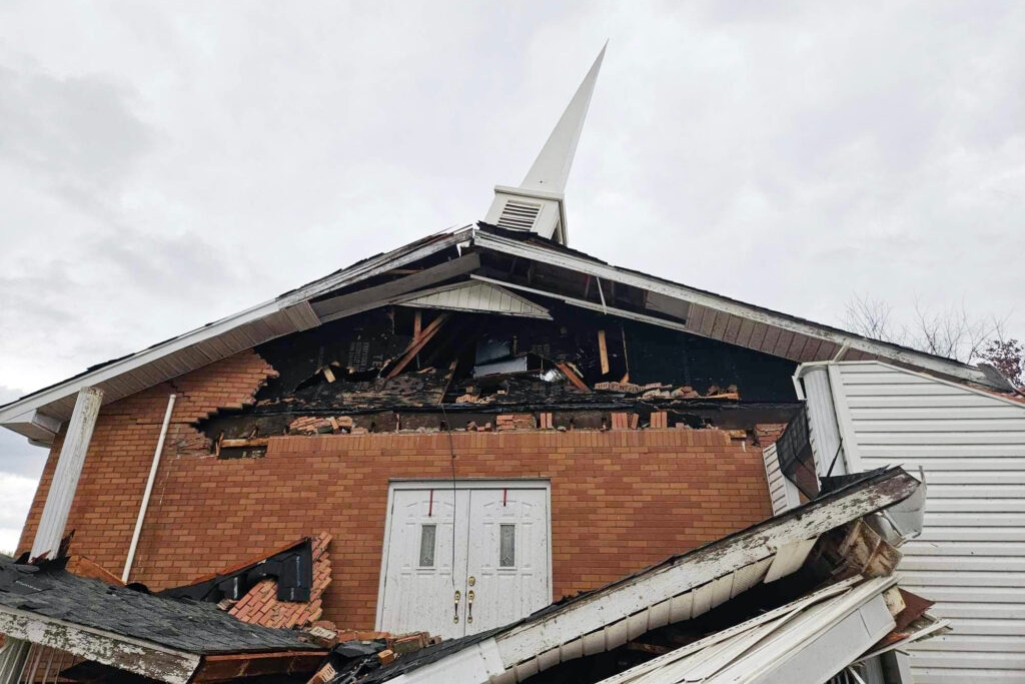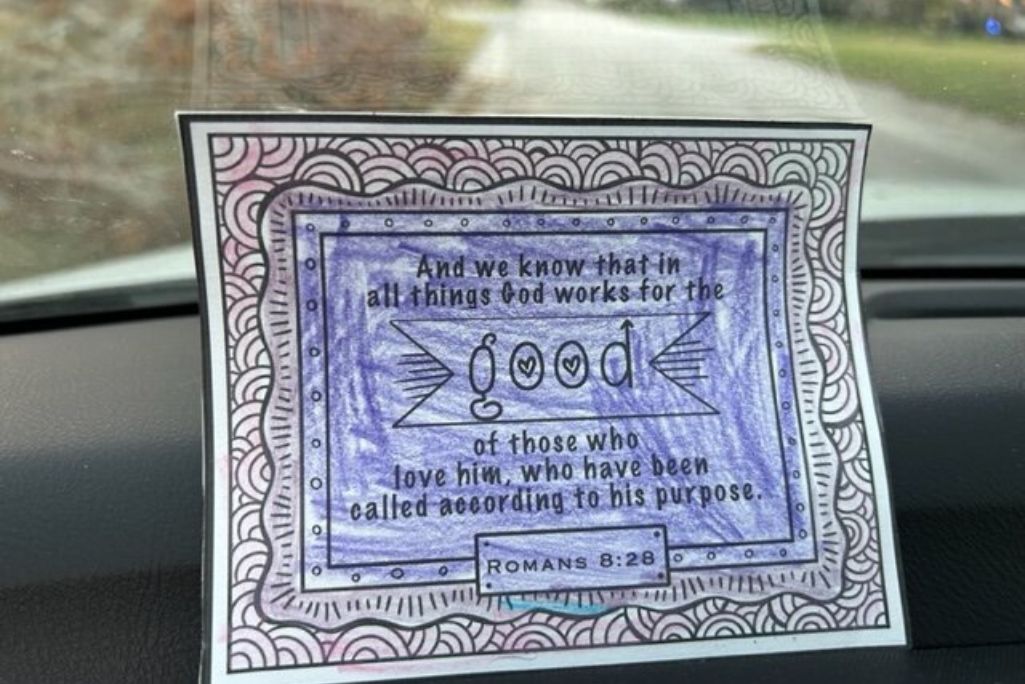
Tom Ascol, in cap, talks with a volunteer as items are collected in Grace Baptist Church's sanctuary in the aftermath of Hurricane Ian.
CAPE CORAL, Fla. – As the emotional and physical trauma from the damage brought by Hurricane Ian continues to impact the southwest Florida peninsula, Grace Baptist Church expanded its ministry response by hosting a town hall-type meeting Dec. 13 for those with insurance questions.
About 50 people attended the event that consisted of a panel of attorneys and professionals acquainted with the insurance industry.
Grace became a hub for relief supplies and ministry in the days after Ian’s Sept. 28 landfall. During that time the sanctuary served as a gathering spot for food, water, baby supplies and numerous other items needed to replace those that had either been blown away or were under piles of rubble.
The church building itself sustained damage to its roof and will need to be replaced, Senior Pastor Tom Ascol told Baptist Press. The loss of several damaged air conditioning units was felt in the Florida humidity alongside temperatures that remained in the high 80s and into the 90s.
“We’re back on a regular schedule; we just don’t have all of our classes running again,” he said. “We met outside for a little bit.”
The first post-Ian Sunday service, Oct. 2, was held in the darkened fellowship hall, with attendees spilling outside.
“There was no electricity, so I just shouted,” Ascol chuckled. “It was brief, because it was hot.”
Grace began meeting in its worship center again on Oct. 15 in the mornings. Corporate prayer meetings resumed Oct. 19 with regular Sunday evening services returning Oct. 30. Some children’s Sunday School classes are back, as is one unified adult class – “Theology of Tragedy and Suffering” – taught by Ascol. Hopes are to resume remaining classes by Jan. 8.
Electricity was fully restored on Oct. 14, though random outages still occur.
There is no good time for a hurricane. But Ian just happened to make landfall as Ascol and his wife, Donna, were more than 1,600 miles away, enjoying a hard-earned vacation in Estes Park, Colo. Ascol had considered holding off on the trip, but indications (at that point) that Ian would miss Cape Coral and Grace’s elders’ encouragement for him to take the time off convinced him otherwise.
The trip was cut short days in, with the Ascols returning on a red-eye flight Sept. 29 and landing in Ft. Lauderdale.
Grace Baptist and many of its members’ homes sat on the southern edge of Ian’s eye wall as it passed, for hours bearing winds reaching 140-150 mph. No one in the church emerged unscathed, with several members losing their homes and many more displaced.
Ascol’s home sustained some roof and window damage, with trees in the immediate vicinity scattered like a game of pick up stix, he said.
A resident of the area for 36 years, Ascol had seen the region’s barrier islands cause many storm systems to veer away. Hurricane Charley changed that in 2004. Like Ian, it was a Category 4, but came in small and fast.
“Everyone expected the storm surge to be devastating, but we never got it because Charley moved so rapidly,” Ascol said. “It messed up our house [and] messed up the church facilities we were in at that time, but it wasn’t anything like Ian, which was also a Category 4. It was massive and slow.”
Ian’s storm surge became what had been feared with Charley. Waters rose one to two stories high across approximately 60 miles of Florida coastline and in some areas pushed several miles inland.
The 2022 hurricane season ended on Nov. 30, producing 14 named storms, eight of them hurricanes. Ian made two landfalls – the first at Cayo Costa, Fla., and then on Sept. 30 as a Category 1 at Georgetown, S.C. Its 150 mph maximum sustained winds as it roared through Florida tied it for the fifth-strongest hurricane to make landfall in the U.S.
Ian also became the costliest storm in 2022 and the second-largest insured loss on record after Hurricane Katrina in 2005. Reports of estimated damage range from $40 billion to $65 billion, with some going much higher than even that.
On Dec. 13, Florida Sen. Marco Rubio and U.S. Rep. Byron Donalds issued a letter to President Joe Biden requesting he approve 100 percent cost share of federal dollars to assist area communities.
“More than two months since Ian made landfall, our communities are still reeling,” read the letter. “Debris generated by the storm from wrecked houses and infrastructure is still piled high, stretched from southwest to northeast Florida. Hurricane Ian also caused the catastrophic failure of numerous bridges. The reality on the ground shows that our communities need more time. Lee County is estimated that debris removal could cost $500 million – about half of the county’s annual operating budget.”
As of Dec. 7, the Florida Office of Insurance Regulation reported estimated insured losses at $10.5 billion. Lee County, where Grace Baptist is located, reported more than 234,000 claims. The second most was Charlotte County, to the north, with 98,508 reported claims.
The recovery process is further complicated by new building codes through the Federal Emergency Management Agency. Those stipulations impact homes in flood zones and may mean a substantial number of residents can’t afford to rebuild.
Southern Baptists have been active in the recovery effort.
“I praise God for the good work that Disaster Relief is doing here and other places throughout our nation,” Ascol said.
On the day Sen. Rubio issued his letter to the president, the panel of individuals took the stage at Grace Baptist that evening. For two to three hours, they received questions and gave advice on what has become a frustrating part of the recovery process.
“It’s been an education and steep learning curve,” said Ascol, who holds a bachelor’s degree in sociology from Texas A&M and MDiv and PhD degrees from Southwestern Baptist Theological Seminary. “I got my insurance stuff back from my company for the first time two days ago (Dec. 12) and it’s 11 pages of technical information.
“I understand the English language pretty well, but I’m not sure I understand half of what that said.”
In addition to explaining areas of terminology, panelists informed the audience of practices employed by insurance adjusters that may lead to a lower coverage claim to benefit the insurance company.
One member of Grace was offered $900 by his company to replace windows that are estimated to cost tens of thousands of dollars to replace. A deacon who lives on Sanibel Island got caught between adjusters, one saying his roof damage was caused by wind and the other saying it came from flooding (even though the water didn’t reach that high).
Those stories can weigh people down.
The panelists, all Christians, “came in last night and gave hope to a bunch of people,” Ascol said. “One deacon thanked them for answering questions he didn’t know he had.”
Advice included applying pressure to insurance companies so they honor their responsibilities. Ascol compared it to the parable of the persistent widow in Luke 18.
“These guys equipped us with legal counsel as well as technical counsel. It was really helpful,” Ascol said.
Judging from the positive response and need, a similar event may be held in the future, he said. The church plans to post video from the night to its website.
In January, Ascol will preach for a friend in Kansas who will be celebrating 40 years at the church he planted. Accompanied by his wife, Ascol will then proceed to Colorado to finish the vacation interrupted in September.
Should a classic Rocky Mountain storm pass through after they are settled in, that wouldn’t be the worst thing.
“If we get snowed in and I can have a fireplace and a book,” he said, “I’ll be fine.”
(EDITOR’S NOTE – Scott Barkley is national correspondent for Baptist Press.)


